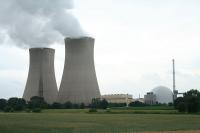About 2,200 nuclear opponents demonstrated outside the Grohnde power station in central north Germany on Sunday 16 January. The protesters, from very young to quite elderly, squatted outside the nuke in a symbolic action. They demanded that the federal and state governments scrap nuclear transport plans. MOX (mixed oxide) fuel from the Sellafied processing plant in Cumbria, northern England, is to be transported to Grohnde. Close to the village of Seascale on the coast of the Irish Sea, Sellafield was formerly known as Windscale.
The consignment is to include 400 kilograms of plutonium. Already one millionth of a gram of plutonium inhaled can cause cancer, opponents say.
Among the demonstrators were 50 farmers with tractors from the region and from the Gorleben area, the site of a nuclear dump.
For the first quarter of this year, the power company E-on has requested permission from the radiation safety authority to bring in 16 plutonium-containing MOX fuel elements. E-on owns 83% of the nuke, commissioned in 1984, the city of Bielefeld the other 17%.
Opponents wrote that in case of an accident with a nuclear consignment followed by a longer fire, or a big collision, plutonium particles could get into the air.
By using MOX, Grohnde will become even more dangerous than other nukes.
The protest was supported by 10 civic action groups across the region, which includes a number of big-population cities. Hanover is 60 km away, Hildesheim 50, Salzgitter 90, Braunschweig 140, Bielefeld 90.
The Grohnde nuke has one reactor that uses 193 fuel assemblies and utilises both enriched uranium and MOX fuel. In 1985, 1986, 1987, 1989, 1990 and 1998 the reactor produced more net electricity for the respective year than any other reactor in the world. The plant is of the pressurised water reactor type, using four water based coolant cycles, kept under high pressure.

